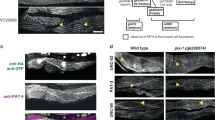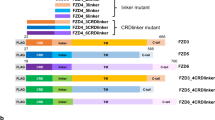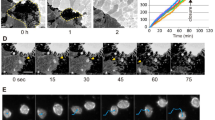Abstract
In flies and vertebrates, Armadillo/β-catenin forms a complex with Tcf/Lef-1 transcription factors, serving as an essential co-activator to mediate Wnt signalling. It also associates with cadherins to mediate adhesion. In Caenorhabditis elegans, three putative β-catenin homologues have been identified: WRM-1, BAR-1 and HMP-2. WRM-1 and the Tcf homologue POP-1 mediate Wnt signalling by a mechanism that has challenged current views of the Wnt pathway1,2,3. Here we show that BAR-1 is the only β-catenin homologue that interacts directly with POP-1. BAR-1 mediates Wnt signalling by forming a BAR-1/POP-1 bipartite transcription factor that activates expression of Wnt target genes such as the Hox gene mab-5. HMP-2 is the only β-catenin homologue that interacts with the single cadherin of C. elegans, HMR-1. We conclude that a canonical Wnt pathway exists in C. elegans. Furthermore, our analysis shows that the functions of C. elegans β-catenins in adhesion and in signalling are performed by separate proteins.
This is a preview of subscription content, access via your institution
Access options
Subscribe to this journal
Receive 51 print issues and online access
$199.00 per year
only $3.90 per issue
Buy this article
- Purchase on Springer Link
- Instant access to full article PDF
Prices may be subject to local taxes which are calculated during checkout





Similar content being viewed by others
References
Rocheleau, C. E. et al. Wnt signaling and an APC-related gene specify endoderm in early C. elegans embryos. Cell 90, 707–716 (1997).
Rocheleau, C. E. et al. WRM-1 activates the LIT-1 protein kinase to transduce anterior/posterior polarity signals in C. elegans. Cell 97, 717–726 (1999).
Shin, T. H. et al. MOM-4, a MAP kinase kinase kinase-related protein, activates WRM-1/LIT-1 kinase to transduce anterior/posterior polarity signals in C. elegans. Mol. Cell 4, 275– 280 (1999).
Miller, J. R. & Moon, R. T. Signal transduction through β-catenin and the specification of cell fate during embryogenesis. Genes Dev. 10, 2527–2539 ( 1996).
Cadigan, K. M. & Nusse, R. Wnt signaling: a common theme in animal development. Genes Dev. 11, 3286– 3305 (1997).
Ruvkun, G. & Hobert, O. The taxonomy of developmental control in Caenorhabditis elegans. Science 282, 2033–2041 (1998).
Costa, M. et al. A putative catenin-cadherin system mediates morphogenesis of the Caenorhabditis elegans embryo. J. Cell Biol. 141, 297–308 (1998).
Eisenmann, D. M., Maloof, J. N., Simske, J. S., Kenyon, C. & Kim, S. K. The β-catenin homolog BAR-1 and LET-60 Ras co-ordinately regulate the Hox gene lin-39 during Caenorhabditis elegans vulval development. Development 125, 3667–3680 (1998).
Maloof, J. N., Whangbo, J., Harris, J. M., Jongeward, G. D. & Kenyon, C. A Wnt signaling pathway controls Hox gene expression and neuroblast migration in C. elegans. Development 126, 37–49 ( 1999).
Lin, R., Thompson, S. & Priess, J. R. pop-1 encodes an HMG box protein required for the specification of a mesoderm precursor in early C. elegans embryos. Cell 83, 599–609 (1995).
Lin, R., Hill, R. J. & Priess, J. R. POP-1 and anterior-posterior fate decisions in C. elegans embryos. Cell 92, 229– 239 (1998).
Thorpe, C. J., Schlessinger, A., Carter, J. C. & Bowerman, B. Wnt signaling polarises an early C. elegans blastomere to distinguish endoderm from mesoderm. Cell 90, 695– 705 (1997).
van de Wetering, M. et al. Armadillo coactivates transcription driven by the product of the Drosophila segment polarity gene dTCF. Cell 88, 789–799 ( 1997).
Behrens, J. et al. Functional interaction of β-catenin with the transcription factor LEF-1. Nature 382, 638– 642 (1996).
Molenaar, M. et al. XTcf-3 transcription factor mediates β-catenin-induced axis formation in Xenopus embryos. Cell 86, 391–399 (1996).
Riese, J. et al. LEF-1, a nuclear factor co-ordinating signaling inputs from wingless and decapentaplegic. Cell 88, 777–787 (1997).
Brunner, E., Peter, O., Schweizer, L. & Basler, K. pangolin encodes a Lef-1 homologue that acts downstream of Armadillo to transduce the Wingless signal in Drosophila. Nature 385, 829–833 (1997).
Korinek, V. et al. Constitutive transcriptional activation by a β-catenin-Tcf complex in APC-/- colon carcinoma. Science 275, 1784–1787 (1997).
Kenyon, C. A gene involved in the development of the posterior body region of C. elegans . Cell 46, 477–487 (1986).
Salser, S. & Kenyon, C. Activation of a C. elegans Antennapedia homologue in migrating cells controls their direction of migration. Nature 355, 255– 258 (1992).
Harris, J., Honigberg, L., Robinson, N. & Kenyon, C. Neuronal cell migration in C. elegans: regulation of Hox gene expression and cell position. Development 122, 3117 –3131 (1996).
Sawa, H., Lobel, L. & Horvitz, H. R. The Caenorhabditis elegans gene lin-17 , which is required for certain asymmetric cell divisions, encodes a putative seven-transmembrane protein similar to the Drosophila Frizzled protein. Genes Dev. 10, 2189–2197 (1996).
Meneghini, M. D. et al. MAP kinase and Wnt pathways converge to downregulate an HMG-domain repressor in Caenorhabditis elegans. Nature 399, 793–797 (1999).
Thorpe, C. J., Schlessinger, A. & Bowerman, B. Wnt signalling in Caenorhabditis elegans: regulating repressors and polarising the cytoskeleton. Trends Cell Biol. 10, 10–17 (2000).
Morin, P. J. et al. Activation of β-catenin-Tcf signaling in colon cancer by mutation in β-catenin or APC. Science 275, 1787–1790 (1997).
Rubinfield, B. et al. Stabilisation of β-catenin by genetic defects in melanoma cell lines. Science 275, 1790– 1792 (1997).
Simcha, I. et al. Differential nuclear translocation and transactivation potential of β-catenin and Plakoglobin. J. Cell Biol. 141 , 1433–1448 (1998).
Orsulic, S. & Peifer, M. An in vivo structure-function study of Armadillo, the β-catenin homologue, reveals both separate and overlapping regions of the protein required for cell adhesion and for Wingless signaling. J. Cell Biol. 134, 1283– 1300 (1996).
Fagotto, F., Funayama, N., Glück, U. & Gumbiner, B. M. Binding to cadherins antagonises the signaling activity of β-catenin during axis formation in Xenopus. J. Cell Biol. 132, 1105–1114 (1996).
Christofori, G. & Semb, H. The role of the cell-adhesion molecule E-cadherin as a tumour-suppressor gene. Trends Biochem. Sci. 24, 73–76 ( 1999).
Acknowledgements
We thank L. Meyaard for critically reading the manuscript and members of the Clevers laboratory for helpful discussions; C. Kenyon for the mab-5 reporter muIs2; Q. Ch’ng and C. Kenyon for tips on staining muIs2 animals for β-galactosidase expression; and A. Fire for pPD49.78. This work was supported in part by an NIH grant to M.H and PIONEER and Program grants from NWO Medische Wefenschappen to H.C.
Author information
Authors and Affiliations
Corresponding author
Rights and permissions
About this article
Cite this article
Korswagen, H., Herman, M. & Clevers, H. Distinct β-catenins mediate adhesion and signalling functions in C. elegans. Nature 406, 527–532 (2000). https://doi.org/10.1038/35020099
Received:
Accepted:
Published:
Issue Date:
DOI: https://doi.org/10.1038/35020099
This article is cited by
-
An instructive role for C. elegans E-cadherin in translating cell contact cues into cortical polarity
Nature Cell Biology (2015)
-
Loss-of-function of β-catenin bar-1 slows development and activates the Wnt pathway in Caenorhabditis elegans
Scientific Reports (2014)
-
VE-cadherin at a glance
Cell and Tissue Research (2014)
-
Pathology and pathogenesis of craniopharyngiomas
Pituitary (2013)
Comments
By submitting a comment you agree to abide by our Terms and Community Guidelines. If you find something abusive or that does not comply with our terms or guidelines please flag it as inappropriate.



